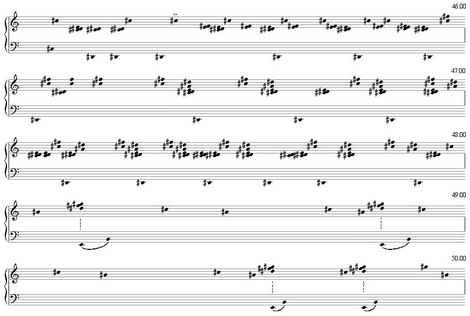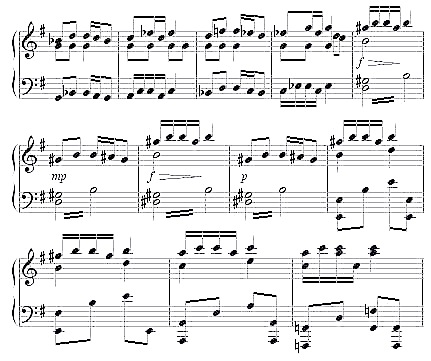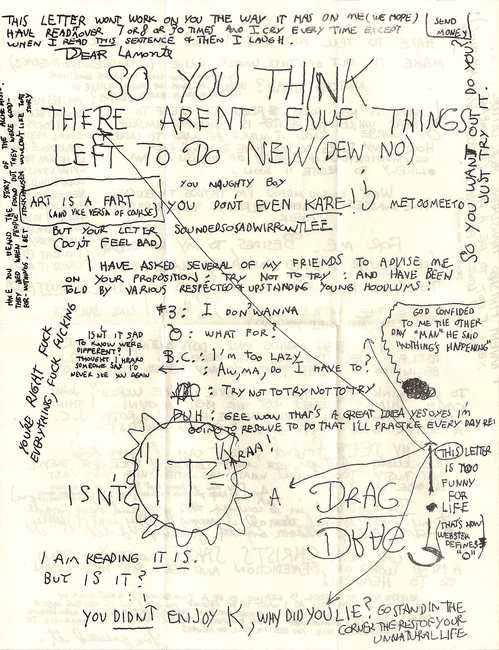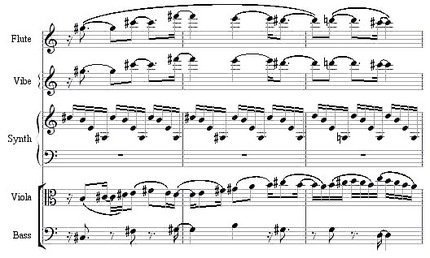main: June 2009 Archives

And here's an mp3 of this passage in the original 1962 recording so you can compare. (I suppose you might have to reopen Postclassic in an additional browser window to listen and follow along at once.) This is one of my favorite moments in the performance, where the relatively dense (by '50s minimalism standards) section on the dominant of G# minor gives way to a kind of beatific deceptive cadence and much slower material. Each section of the piece, each tonality, has its own atmosphere and tempo that seems drawn from the intervals played around with.
And that's the problem: you can't gather that from the original notation. The first three systems above are all drawn from this little bit of Johnson's score labeled IIIa and IIIb:

Wherever this material recurs, it's the fastest part of the piece, with a kind of anxious melody leading down from F# to D# to C#. In some notes he apparently made later in the 1980s, Johnson singles this material out to try to figure out what his logical process was, which was a kind of ABACABACDCDB, and so on, among closely related figures. The E major material that follows, on the other hand, doesn't appear in the manuscript score at all. The piece is intended to be improvised from the scores, and needn't duplicate the tape; in fact, an alleged four hours is missing from the tape. So neither the score nor the tape is sufficient to construct a performance. Using the score, a pianist could play the work, but only after considerable study of the available 112 minutes on the tape, to find out how Johnson moved from one section to another and how he characterized the material in each section. It's a peculiarly hybrid form of improvisation, in which you're limited to what's on the page, but the page isn't enough. Hopefully my transcription will yield up enough analytical insight to resurrect some version of the whole thing.
I was told that the committee pretty much had to make a decision that day, and by the time I flew back I already had a "thanks but no thanks" e-mail waiting. It came as a relief: not because I didn't want the job, nor because anything had made a sour impression on me, but because I would have had to make one of the most momentous decisions of my life with almost no evidence to base it on. It's like they see teaching jobs as interchangeable posts and expect professors to glide thoughtlessly from school to school as advantage dictates, without homes, families, or roots to put down (and it was explicitly a senior position). One might speculate that the committee spent little time with the candidates because, as happens occasionally at schools everywhere, they already knew who they wanted to hire, and were just going through the motions. If so, however, it would have been wasteful of them to pay to fly me across the Atlantic for a charade; and at one point they were forced to redefine and relist the position, and they asked me to reapply, so I feel certain I was a serious contender.
The only sad thing is that I love England and would love to teach there, but if all their interviews are like this, I can't imagine that I would ever gain enough confidence from succeeding at one to sell my beautiful, almost-paid-for house and move tens of thousands of compact discs, not to mention books, scores, grand piano, wife, dog, and two cats, across an ocean. And yet I'm not prepared to claim that the English system is inferior to ours, just that it seems counterintuitive. American schools put tremendous, perhaps quixotic, emphasis on assessing collegiality. The longest interview I ever had, at Bard, lasted two and a half days, and I've heard of others that ran longer. We want to eat with the candidate, watch him teach, watch him drink, plumb his opinions, see him react to provocation, and in the end, what good does it do? Interviewing at one school, once, I was taken to dinner by two music faculty who proceeded to have a shouting fight with each other, in the restaurant, as I looked on in mute astonishment. At another, early in my career, the chair of the search committee took me to lunch privately, and pressed me at uncomfortable length to reveal my sexual orientation, with the unmistakable implication that he favored bisexuals. (And I'd call that only the third most unpleasant academic interview I've ever had.)
It's always struck me as reasonable that marriages had just as much chance of being successful back in the old days, when they were arranged by astrologers and matchmakers with the bride and groom not meeting each other until the wedding, as they do today. Similarly, perhaps the idea that we can gauge collegiality over a three-day interview and predict future compatibility from a tense private breakfast is no more than a hopeful myth. All comparative experience I've heard of suggests that a music department, any music department, any academic department, anywhere, gets described by its members as the proverbial nest of vipers in which one will find a few allies, but ultimately learn to keep one's head down and teach with hope of nothing better than a comparative absence of interference. So perhaps it's best to get the process of entering one over with as quickly as possible, relying on the most superficial and documentable criteria. Or hell, consult the I Ching for each candidate. As academic interviews go, this one was certainly pleasant and dignified, with no opportunity given for momentary humiliation or discomfort. I have no evidence that the more labor-intensive, touchy-feely American system guarantees more enviable results. But I also feel that, given the exorbitant cost of flying me on short notice to their scepter'd isle, the English faculty were allowed precious little information about me in return.
I do, however, try to discover one new single-malt scotch whenever I visit England, and I came back with a superb 14-year-old Bunnahabhain. (I think the name is Scots dialect for "That's a smart rabbit," or "I'm the bane of that rabbit's existence.") Of it, Jim Murray's 2009 Whisky Bible states, "I thought I noticed it when I tasted it late last year, and earlier this. 'Where's that bracing, mildly tart, eye-watering Bunna that I so adore?' I wondered. Thankfully no sign of the sulphur that caused so many problems for so long. But something, I thought, was missing... I can report there is no shortage of charm and the earliest barley belt on the palate rocks. But the fire has been doused, most probably by caramel." I can see what he means, but I like caramel, and Bunnahabhain is a luxuriously soothing contrast to my usual more demanding Caol Ila. In 2007 dollars the bottle would have cost me $79, but at today's exchange rate I was put out only $49. Such delicious revenge was worth an 18-hour round-trip flight.
UPDATE: I have to compliment one side-effect of the British interview process, though, that seemed extremely civilized. Spending the day with the other candidates humanized them. Usually when some asshole gets a job I applied for I assume he's a Davidovsky protégé who slept with the right grad school teachers and writes music so convoluted that it threatens no one. But here it felt like the five of us were sort of in this together, and I was sincerely happy for the nice guy who was offered the job. That's never happened before.
In 1933-34, John Cage moved to New York at Henry Cowell's advice, to study with Adolph Weiss - but also found himself playing cards with Weiss and Wallingford Riegger. In 1941, a 15-year-old Morton Feldman studied with Riegger. And later in 1952 or '53, Riegger took a sabbatical replacement position at Manhattan School of Music, where a young Robert Ashley was pursuing his Master's degree. Ashley and Riegger both had apartments on the East Side, and ended up taking the same bus to school every day. Riegger was the first composition teacher Ashley had found sympathetic, and Ashley remembers being the only kid in class interested in the 12-tone techniques Riegger was teaching. Riegger wrote an astonishing Study in Sonority in 1928, more radical to my ears than anything Schoenberg had yet done, and attractive Third and Fourth Symphonies and a Piano Concerto all in a 12-tone idiom, and also a beautifully retro Canon and Fugue in old-fashioned D minor.
I'm not a real music historian, but I'm a sufficiently enthusiastic fake one to get a kick from knowing and drawing these connections. We don't think, for example, of Cage and Ralph Shapey inhabiting the same scene, but at some point circa 1950 they, along with Feldman, were drawn into the orbit of Stefan Wolpe; and ten years later, we find Wolpe and Cage hobnobbing with Cage's New School student Toshi Ichiyanagi and his new bride Yoko Ono. Someday there will be a book on James Tenney, who studied with Varese, befriended Ruggles, argued with Partch, made psychedelic eletcronic music with Mort Subotnick, played in the ensembles of Steve Reich and Phil Glass, taught alongside Harold Budd, and taught Peter Garland, Larry Polansky, John Luther Adams, and Michael Byron, among many others. Tenney is a line wandering through American musical history, drawing a variety of unexpected connections. The people most central to American music, those who can't be pulled out of the fabric without it unraveling, are not always the household names.
And so interviewing Ashley (12 hours so far this week) is one of the most exciting things I've ever done. He doesn't like reminiscing about the past - he thinks I should concentrate on his most recent ideas - and doesn't realize how quietly the history of 20th-century music falls into focus as he tells me about all the contacts he made in his youth. (One thing I learned - Luciano Berio was a wealthy man from the beginning. Why? Heir to the Berio olive oil fortune. I think of Berio every time I see that olive oil in the grocery store, but never knew the connection.) Yesterday, Ashley told me:
"The only thing that's interesting to me right now is that, up to me and a couple of other guys, music had always been about the eventfulness: like, when things happened, and if they happened, whether they would be a surprise, or an enjoyment, or something like that... It's about eventfulness. And I was never interested in eventfulness. I was only interested in sound. I mean, just literally, sound in the Morton Feldman sense.... There's a quality in music that is outside of time, that is not related to time. And that has always fascinated me... That's sort of what I'm all about, from the first until the most recent. A lot of people are back into eventfulness. But it's very boring. Eventfulness is really boring."
It reminded me strongly of when, years ago, La Monte Young showed me his early string quartet in which the five movements are all almost identical, and I asked him why, and after a moment's musing he responded, "Contrast is for people who can't write music." When I quote that there are always people who get defensive and agitated about it, but for many of us, that's just our aesthetic. It's not going to replace Mozart, and you'll still get to hear Stravinsky, and there's no reason to think that our saying that is the end of the world, and that we have to be smothered, or stopped, or else we'll bring the whole edifice of culture crashing down. For some of us, eventfulness is boring, contrast is unnecessary, and we're interested in the aspects of music that don't relate to time. And the fact that we moved to that in a single generation from Riegger and Wolpe, and that these important threads can be teased out of history, is a tremendously thoughtful pleasure.
UPDATE: McLaren points out in comments that Riegger's Study in Sonority isn't currently available in any form. So here it is.
For instance, in 1980 Austin Clarkson interviewed Morty about his teacher Stefan Wolpe, and asks him about Ernst Krenek:
MF: Well, you see, what Krenek didn't do, what Stefan did was that he was a competitor. Krenek felt the fact that he had a success when he was young [Jonny Spielt Auf, I assume], and he was married to Schoenberg's daughter [but see comments], that he was given a crown and he could go and fall asleep with his own ideas for the rest of his life. Wolpe was in the midst of a musical revolution in New York. He was in the midst of the rising young, fabulously talented people coming up in Europe, and he knew it. Krenek never knew it. There's not an ounce in Krenek's music, in things that I've heard of his late style... But nothing existed, nothing happened. It's music where nothing happened. It's the kind of music somebody might write some place in Adelaide, Australia. But Wolpe is caught up in world events, musical events, and things happened...
MF: To show you [Wolpe's] identification with the avant-garde, he once balled me out, very strongly, for never playing him in our concerts in the early '50s. The Cage concerts. He balled me out. He was sore. But he did identify with the younger people... which certainly most of his students didn't. Ralph [Shapey] didn't, none of his students around him. I don't know what they identified with. They identified not with Wolpe so much, but the tradition which Wolpe came out of. [p. 107, itals and ellipses in the original]
And, asked about Wolpe's early interest in Satie:
MF: ...I'll tell you what happened to Satie and the whole idea that independents couldn't survive in Europe, just couldn't survive the way they survive here. That some of our strongest people today are independents, where do you put them? Like George Crumb. He was a big influence, and yet he is an independent really. George Crumb couldn't happen in Europe, essentially. With all the European cliques it couldn't happen. And so Wolpe added to the whole category of very strong independent composers in America. I think that the best thing is to push him as an American rather than as a European. That way you'll get a little more mileage, because if you're going to push him as a European, they're going to say, well, what is this in relation to... we have this over here, which is what they say. [pp. 107-8]
And how Feldman met Wolpe:
MF: I'll tell you how I heard about Wolpe. I was just a kid out in Queens. I didn't know anybody. A friend of mine - I'm not going to mention his name, because his name is known to some degree - thought very highly of himself and sent a score of his to [Dmitri] Mitropolous. Mitropolous saw essentially that he was still a student, even though the young man didn't think he was still a student, and suggested that he work with Wolpe. I lost my friend, and I was very close to this friend, because he came back and he told me about a visit he had with Wolpe where they just didn't get along at all, anything that Wolpe had to say. And I listened to this conversation very clinically, and I listened to the things that Wolpe said to my friend, and I gave it a little thought, and three days later I called up Wolpe and asked him if I could come see him. I mean, he sounded to me like a terrific teacher, and I lost a friendship of a young colleague at the time for betraying him. "How could you go to Wolpe after telling how Wolpe insulted me?" But he sounded like a good teacher to me. [laughs] And that was the smartest thing I ever did was to lose that friend and not have that sense of loyalty. [p. 109]
Fascinating and endearing stuff (apologies, though, to any composers in Adelaide). Anyone know who the friend was?
Meanwhile, there's an old, frail copy of an "Analytic Symphony Score" piano reduction of Dvorak's New World Symphony, which I found at a wonderful little used book store in Great Barrington, sitting on my piano, edited by Percy Goetschius, Mus. Doc. I'm a big fan of Percy Goetschius, Mus. Doc. - I've even got the same degree. I collect his theory books, published in the late 19th century (I first found one years ago in Trimpin's library), and love reading them. They're bracingly, menacingly hard-core. The fourth scale degree always resolves to the third, the seventh must rise to the octave, a iii6-4 chord can only follow I, and if you brazenly start a modulation with the I (one) chord of the new key as your pivot - well, may God have mercy on your soul, that's all Percy has to say. In my dreams I imagine teaching a beginning theory class with Percy's The Theory and Practice of Tone-Relations (1892), but the students would feel like they were on a chain gang. Every piece of music they look at would break Percy's iron-clad rules, and I'd have a hell of a time finding suitably strict musical examples. And yet, reading him, the reasons music is the way it is fall into place, and random-looking conventions come to seem inescapably logical. There is a reason, generally, to avoid the I chord as a pivot. Probably 98 percent of iii6-4 chords follow I with passing motion in the bass. The essence of music shines forth, isolated in the tight little net of Percy's mandates. This is a real man's theory, with none of your current-day liberal mollycoddling.
Percy's piano reduction of the New World Symphony makes me wish I had taught the piece in the 19th-century course I just completed (the one whose papers I have yet to grade). I've never taught Dvorak, not having much use for him (I prefer the 5th, 6th, and 8th symphonies to the 9th, at least), but playing through it, I realize that the first movement of the New World is the most pedantically clear Romantic sonata-allegro I know of. Every melodic phrase is four measures. (Percy says every melody is four measures at heart: maybe two if it's slow, or eight if it's fast, and other lengths have to be accounted for by extensions or elisions. It's easy to see why he liked the New World.) Every four-, two- or one-measure unit gets repeated. Sometimes the tune is the same and the harmony changes, sometimes the notes change but the rhythm is repeated, sometimes the rhythm changes but the pitches are retained, but there's a fanatical insistence on leading the ear from measure to measure. No measure comes as a surprise, or almost even a contrast.

Really not so far from early minimalist practice, only less gradual and with conventional chord teleology. It's a smooth, smooth piece, didactically so; a child could make sense of it on first hearing. Its popularity with audiences couldn't be more explainable. Infinitely inferior to Brahms: one would almost wonder why Brahms so promoted Dvorak's career, except that it is the immemorial habit of composers to champion other composers whose works are in the same general style as their own but not as good. (An entire history of music could be written elucidating that one principle, especially in the post-WWII era when composers came to run the new-music performance scene.) But the New World - little more than a harmonic progression articulated by repetitious motives - would make a wonderful teaching piece, a template for composing large-scale forms by monotonous formula. The subtle continuities of Brahms, Bruckner, and Mahler are a little too creative and elevated for undergrads to understand, but the New World is right at their level, and assimilating it would make those other composers shine even more brightly. - Kyle Gann, Mus. Doc.
AAAAAAACHHOOOOO!
 A new novel by Lori Andrews called Immunity contains a character named Peter Gena, a professor at the School of the Art Institute of Chicago, who creates computerized programs that turn the DNA sequences of various diseases into pieces of music. Although Peter is not truly fictional: in fact, he was my composition teacher in grad school at Northwestern, and he really does make a wide variety of scintillating pieces for Disklavier and other electronics from DNA sequences. Andrews heard about him through a mutual geneticist friend whom Peter collaborates with, and mentions him twice in the book, on pages 9 and 41. Immunity is a kind of action novel about a sexy geneticist named Alexandra Blake who tries to unravel an epidemic caused by someone infecting drinking water with a toxin that makes people fatally allergic to man-made substances. Blake listens to DNA sequences through Gena's program to try to hear dissonances that alert her to problematic viruses. It's a very fast read that comes off like a would-be film script, with all the characters using the same kind of curt, snappy dialogue. I spent a lovely weekend with Peter the last couple of days, and realized again what a felicitous meeting of minds we were, and how lucky I was to have studied with him. (Among hundreds of happy coincidences: I've been meaning to listen to Saint-Saens's Third Symphony because McLaren recommended it to me in a recent comment. Peter put on a CD to show off his new stereo components. "What is this?," I asked. It was Saint-Saens's Third Symphony.) Thank goodness Peter wasn't merely fictional.
A new novel by Lori Andrews called Immunity contains a character named Peter Gena, a professor at the School of the Art Institute of Chicago, who creates computerized programs that turn the DNA sequences of various diseases into pieces of music. Although Peter is not truly fictional: in fact, he was my composition teacher in grad school at Northwestern, and he really does make a wide variety of scintillating pieces for Disklavier and other electronics from DNA sequences. Andrews heard about him through a mutual geneticist friend whom Peter collaborates with, and mentions him twice in the book, on pages 9 and 41. Immunity is a kind of action novel about a sexy geneticist named Alexandra Blake who tries to unravel an epidemic caused by someone infecting drinking water with a toxin that makes people fatally allergic to man-made substances. Blake listens to DNA sequences through Gena's program to try to hear dissonances that alert her to problematic viruses. It's a very fast read that comes off like a would-be film script, with all the characters using the same kind of curt, snappy dialogue. I spent a lovely weekend with Peter the last couple of days, and realized again what a felicitous meeting of minds we were, and how lucky I was to have studied with him. (Among hundreds of happy coincidences: I've been meaning to listen to Saint-Saens's Third Symphony because McLaren recommended it to me in a recent comment. Peter put on a CD to show off his new stereo components. "What is this?," I asked. It was Saint-Saens's Third Symphony.) Thank goodness Peter wasn't merely fictional.Sites To See
AJ Ads
AJ Blogs
AJBlogCentral | rssculture
Terry Teachout on the arts in New York City
Andrew Taylor on the business of arts & culture
rock culture approximately
Laura Collins-Hughes on arts, culture and coverage
Richard Kessler on arts education
Douglas McLennan's blog
Dalouge Smith advocates for the Arts
Art from the American Outback
For immediate release: the arts are marketable
No genre is the new genre
David Jays on theatre and dance
Paul Levy measures the Angles
Judith H. Dobrzynski on Culture
John Rockwell on the arts
Jan Herman - arts, media & culture with 'tude
dance
Apollinaire Scherr talks about dance
Tobi Tobias on dance et al...
jazz
Howard Mandel's freelance Urban Improvisation
Focus on New Orleans. Jazz and Other Sounds
Doug Ramsey on Jazz and other matters...
media
Jeff Weinstein's Cultural Mixology
Martha Bayles on Film...
classical music
Fresh ideas on building arts communities
Greg Sandow performs a book-in-progress
Exploring Orchestras w/ Henry Fogel
Harvey Sachs on music, and various digressions
Bruce Brubaker on all things Piano
Kyle Gann on music after the fact
Greg Sandow on the future of Classical Music
Norman Lebrecht on Shifting Sound Worlds
publishing
Jerome Weeks on Books
Scott McLemee on books, ideas & trash-culture ephemera
theatre
Wendy Rosenfield: covering drama, onstage and off
Chloe Veltman on how culture will save the world
visual
Public Art, Public Space
Regina Hackett takes her Art To Go
John Perreault's art diary
Lee Rosenbaum's Cultural Commentary
Tyler Green's modern & contemporary art blog




